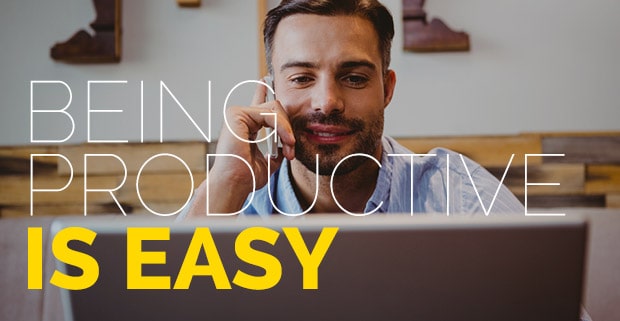 Image of smiling businessman on phone from Shutterstock.
Image of smiling businessman on phone from Shutterstock.
There are plenty of self-help books on how to completely revolutionize your life, but they take time, commitment, and a varying degree of effort that seems to range from medium output to forgetaboutit. Emma Bullen promises to help make you more productive with very little effort.
As human beings, we love habits. Whether it’s our route to work or the way we organize our emails, we do things time and time again because they work. What if I told you, you could be more effective by using your existing habits? Instead of reading dozens of self-help books that promise to revolutionise your lifestyle, you could make significant changes by building on your established routines. Sound intriguing?
Habit Stacking is a simple technique for getting more done by adding to our existing systems. How does it work?
The science
In 2007, scientists in Oxford learned that babies had 40 per cent more neurons processing information in the brain than adults. They discovered something called “synaptic pruning” which happens when the brain chooses to strengthen established connections (habits, like your daily commute to work) over weak connections (something you do less frequently, like lead an annual board meeting). As your established habits are already strongly wired into the brain, new habits that you build on top of them are quicker and easier to grow.
To become an expert habit stacker, all you need is motivation, a call-to-action based on an existing habit, and the ability to get something done. Now, let’s get started:
List What You Already Do
Chances are, you have some good habits already — whether you’re aware of them or not. Before you start habit stacking, reflect on what’s already working and identify your routines. Maybe you meditate in the morning, and it keeps you calm; perhaps you plan your day ahead, and it helps you focus.
Once you’ve reflected, it’s time to think about how you can build on those habits. Here’s the formula:
After x, I will y.
Design For the Behaviour, Not the Outcome
Most behaviours are habits you’ve built up over time without a big hairy goal in sight. There’s a reason so many would-be novelists fail to make their 50,000-word deadlines; it turns out that writing a novel takes a lot of work.
One drawback to habit stacking is that you may look a little bit eccentric. But on the plus side, you’ll get a lot more done.
To make it easier to trigger a new good habit, all you need to do is add it to an existing routine. When your new behaviour is established, then — and only then — should you add to it. Don’t aim for the finish line, just start jogging.
Take Baby Steps
The key is to start tiny. Really tiny. “When I arrive in the office, I’ll take the stairs; then I’ll say good morning to the team.”
Once you’ve established up one or two good habits, it’s time to add another. This is where the habit stacking fun begins. “Once I’ve said good morning to the team, I’ll write down the three things I need to get done today.”
Finding it hard to habit stack in the morning? If your day is full of meetings and firefighting, try swapping your habits to an evening routine.
“At the end of the day, I’ll write down three things to do tomorrow, and I’ll turn off my laptop.”
Celebrate Small Successes
Lack of momentum is why our big goals fall flat, no matter how ambitious they seem. Fogg suggests we celebrate small victories, by saying, “awesome!” or doing a happy dance each time we do them. Don’t feel comfortable with doing this in front of your boss? Me neither. In fact, the one drawback to habit stacking is that you may look a little bit eccentric. But on the plus side, you’ll get a lot more done.
There’s no need to revolutionize your lifestyle to get more out of your day. Start habit stacking and you’ll get more done in half an hour than you might have otherwise done in a week.
Emma is a writer and editor with 15 years of experience in print, web, and mobile publishing. British by birth and Canadian by residence, Emma is passionate about learning, storytelling, and em dashes.
What are some of your tips and tricks for creating and sticking to great habits at home and in the workplace? Share your thoughts in the comments section below.